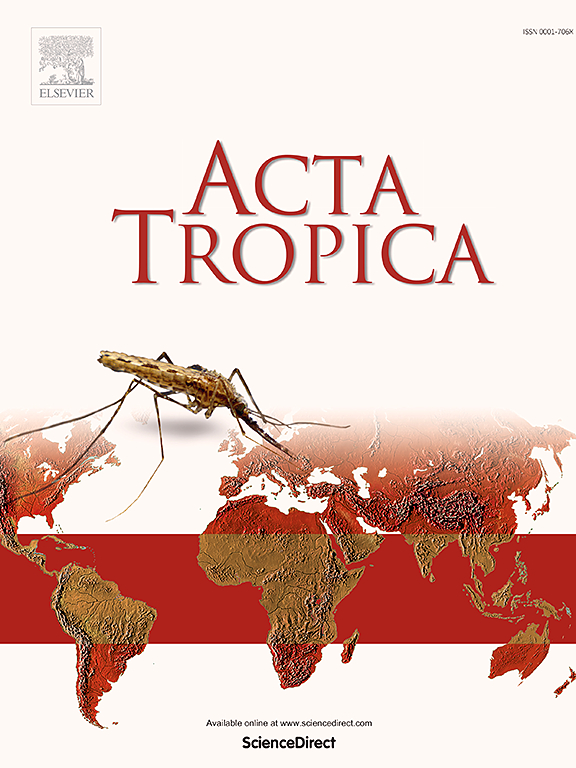新疆牦牛囊虫的遗传多样性和宿主特异性
IF 2.1
3区 医学
Q2 PARASITOLOGY
引用次数: 0
摘要
囊虫是人类和动物常见的肠道病原体。从新疆维吾尔自治区6个县采集826份粪便样本,对囊虫小亚基核糖体RNA (SSU rRNA)基因进行PCR扩增。牦牛囊胚病感染率为75.5%(624/826),采样点不同,河泾为54.2%(156/288),阿克陶为100%(22/22)。0.01)。每个采样点选取约20%囊虫阳性样本(n = 163)进行测序。共鉴定出ST10、ST14、ST21、ST24、ST25、ST26、ST42和ST44 8个亚型,以ST10 (n = 59)为优势亚型,其次为ST26 (n = 41)、ST42 (n = 39)、ST25 (n = 7)、ST14 (n = 6)、ST21 (n = 5)、ST24 (n = 3)、ST44 (n = 3)。163份测序样本共鉴定出22种已知序列类型,遗传多样性较高。上述结果表明,新疆牦牛囊虫感染较为普遍,且具有囊虫亚型宿主特异性。本文章由计算机程序翻译,如有差异,请以英文原文为准。

Genetic diversity and host specificity of Blastocystis in yaks in Xinjiang, northwest China
Blastocystis is a common intestinal pathogen in human and animals. A total of 826 fecal samples were collected from six counties in Xinjiang Uygur Autonomous Region, China, and applied to PCR amplification based on the small subunit ribosomal RNA (SSU rRNA) gene of Blastocystis. The infection rate of Blastocystis in yaks was 75.5 % (624/826), with the different sampling sites varies from 54.2 % (156/288) in Hejing to 100 % (22/22) in Aketao (p < 0.01). About 20 % of the Blastocystis positive samples (n = 163) were selected from each sampling sites to sequenced. Eight subtypes (ST10, ST14, ST21, ST24, ST25, ST26, ST42 and ST44) were identified, with ST10 (n = 59) was the predominant subtype, followed by ST26 (n = 41), ST42 (n = 39), ST25 (n = 7), ST14 (n = 6), ST21 (n = 5), ST24 (n = 3), ST44 (n = 3). 22 known sequence types were identified from the 163 sequenced samples, indicating a marked high genetic diversity. These results indicating that the infection of Blastocystis was common in yaks in Xinjiang, and have host specificity of Blastocystis subtypes in the present study.
求助全文
通过发布文献求助,成功后即可免费获取论文全文。
去求助
来源期刊

Acta tropica
医学-寄生虫学
CiteScore
5.40
自引率
11.10%
发文量
383
审稿时长
37 days
期刊介绍:
Acta Tropica, is an international journal on infectious diseases that covers public health sciences and biomedical research with particular emphasis on topics relevant to human and animal health in the tropics and the subtropics.
 求助内容:
求助内容: 应助结果提醒方式:
应助结果提醒方式:


